Menu

Did you know over 30% of agriculture’s costs go to manual work? This shows how important it is to be efficient. Today, we heavily rely on tech in managing greenhouses. New developments in technology like AI and automation are key.
The market report of 2021 shows more smart greenhouse tech is being used. This tech makes greenhouses work better, increasing their produce. For greenhouses, having good insurance is crucial. It helps deal with the risks that come with managing these high-tech places.
With the population expected to hit 9.8 billion by 2050, we need better farming methods. Greenhouse automation cuts down costs and makes work safer. This is very important in our current COVID-19 world. Many farmers are facing worker shortages due to travel limits for migrant workers.
Modern agriculture is changing fast, thanks to robot-run greenhouses. These greenhouses use the latest AI systems for farming. They manage everything from watering to climate.
The market for farming robots is growing quickly, heading towards $94.22 billion by 2030 worldwide. In particular, robots in greenhouses are getting popular fast, with a 34% yearly growth. This shows how much people are interested in this technology.
Robots in farming bring big benefits. They help control weeds and pests without harmful chemicals, which is good for the planet. These robots also use water and nutrients more efficiently. This means less waste and a more sustainable farm.
Moreover, planting using robots makes better use of space and resources. This can lead to more crops with less waste. Harvesting is easier and faster with robot help. This could mean better quality crops and less work for farmers.
Robots can also keep an eye on the plants and the weather. They can spot problems early, which helps crops grow better. Even though starting with robots can be costly, the gains for farmers can be big.
Farm leaders need to think carefully before they start using robots. They should consider how fast they can grow their robot use. Also, they need to plan for how their workforce will change. Following rules and regulations is essential too.
In the U.S., the number of greenhouse vegetable farms has jumped by 115%. Now, there are 8,750 of them. Using robots can make these farms more productive. For example, using rolling benches can save space. This can help increase the farm’s efficiency by up to 30%.
These figures show that using robots in farms is really changing the game. It’s making farming more efficient and sustainable.
Controlled environment agriculture (CEA) dates back centuries. For example, Tiberius’s cucumber gardens were an early example. Today, greenhouse technology lets us grow crops all year, improving the food supply significantly.
Modern farming technologies use better systems for heating, cooling, and lighting plants. They also include smart irrigation that saves water. This creates the best environment for plants to grow, reducing the impact on the environment.
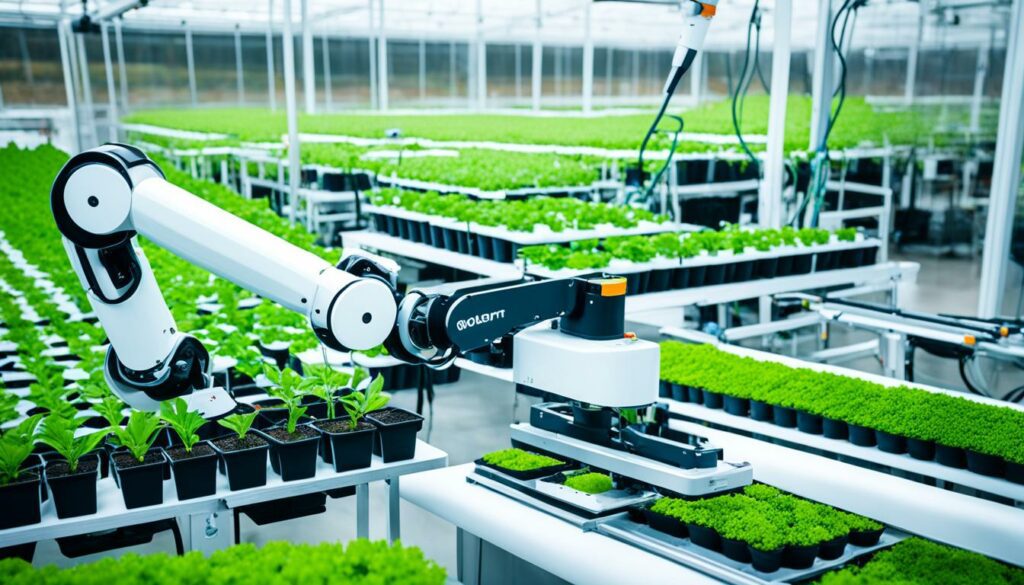
New greenhouses use less energy, thanks to smart design and LED lights. They also have high-tech sensors that keep track of the plants. These technologies help make sure the crops are healthy and abundant.
Today, computers and artificial intelligence help run greenhouses more efficiently. They analyze data to make immediate improvements. This has led to the development of space-saving vertical farming and hydroponics that use less water.
Modern greenhouses protect crops from bad weather. They also reuse water and use natural ways of growing plants. Big data even predicts how to grow crops better. Greenhouse technology has truly come a long way, making farming better for both people and the planet.
Exploring different greenhouse designs shows how automation can really improve farming. There are many modern structures that support growing crops automatically. These can be used for home gardening, big commercial farms, and the newest designs in agriculture.
Commercial greenhouses are at the forefront of automated farming. They mix large-scale growing with the latest tech to really boost production. With systems that water plants automatically and feed them the right nutrients, these greenhouses cut down on waste and manage resources better.
Adding rolling benches into these big greenhouses can make the most of the space, helping save up to 30%. This change isn’t just about fitting more plants in. It also saves money by using space wisely. Companies like Wendy’s prove that moving to these setups can ensure top-quality food all year round.
There’s a big focus now on green ways to grow food without losing productivity. Greenhouses use vertical growing and hydroponics to make the best use of space and water. These methods are vital in a world where there aren’t enough workers and the demand for food keeps growing.
Using robots for things like weeding cuts down on harmful chemicals. This is good for the environment and human health. The rapid growth in this field means that going green makes both economical and environmental sense. Plus, it leads to better plant health and food quality.
Modern greenhouses depend on climate control systems to help plants grow their best. These systems include advanced HVAC systems. They control the temperature and humidity very precisely. Plus, they use lighting controllers that fine-tune conditions for better plant growth and more produce.
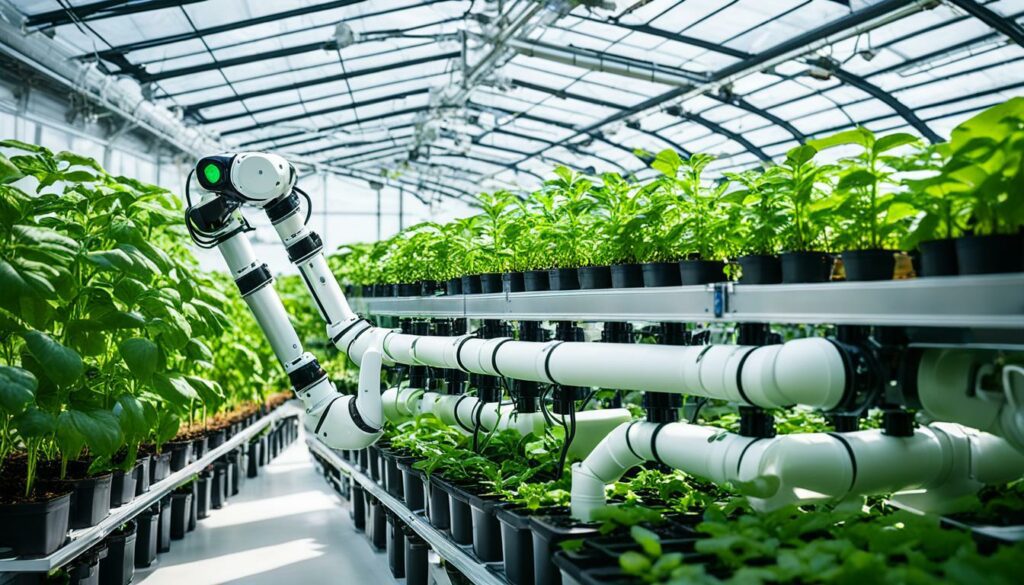
Greenhouses create carefully controlled environments for plants. HVAC systems play a key role by managing heating, ventilation, and cooling. For example, the Growlink System Basic Controller costs $899 and can manage numerous sensors and relays to keep the environment just right for plants.
Damatex includes top-notch Vaisala products, such as the CO2 Probe GMP252 and the HMP60 Humidity and Temperature Probe, for better greenhouse control. This ensures that plants get exactly what they need.
The right temperature and humidity are vital for healthy plants. Tools like the SmartBee Basic Controller ($1949) make it easier. They can monitor and adjust up to eight different devices to keep plant conditions perfect.
The MotorLeaf System allows sales to set up customized systems for each greenhouse. This personalized service ensures every greenhouse gets the right climate. This can lead to more productivity and less waste.
| Controller | Price | Features |
|---|---|---|
| Growtronic Basic Controller | $599 | Humidity/temperature sensor, controllable power outlets |
| Growlink System Basic Controller | $899 | Four sensor inputs, four relays, control up to 1000 controllers |
| Link4 iPonic 624 Basic Controller | $1449.00 | 8 fully-programmable outlets, environmental sensors |
| SmartBee Basic Controller | $1949.00 | Control of up to eight devices, multiple environmental sensors |
Advanced climate systems are changing the horticulture world. They’re making big improvements in how we can grow plants in controlled environments.
Today, modern greenhouses put a high value on managing water well. They use smart irrigation systems to control water precisely. This saves time and resources.
Automated systems are key in modern farming, making work easier and cheaper. They use drip irrigation, sprinklers, and misters to suit various crops. Drip irrigation is common in greenhouses. It sends water right to the plant roots to reduce waste.
Sprinkler systems are another option, good for plants that don’t like getting their leaves wet. Misting systems use fine droplets, great for starting seeds and helping plants grow.
Saving water is essential for sustainable farming. Methods like hydroponics and aeroponics let us use less water. Automating how we feed plants also helps, cutting down on waste.
Machines in greenhouses, like robots, are making farming smarter. They help us use water and other resources more carefully. This trend is growing fast, showing where agriculture is headed.
Horticultural automation in modern greenhouses shows the best of farming’s future. With high-tech machinery and robotic arms, tasks are done quickly and well.
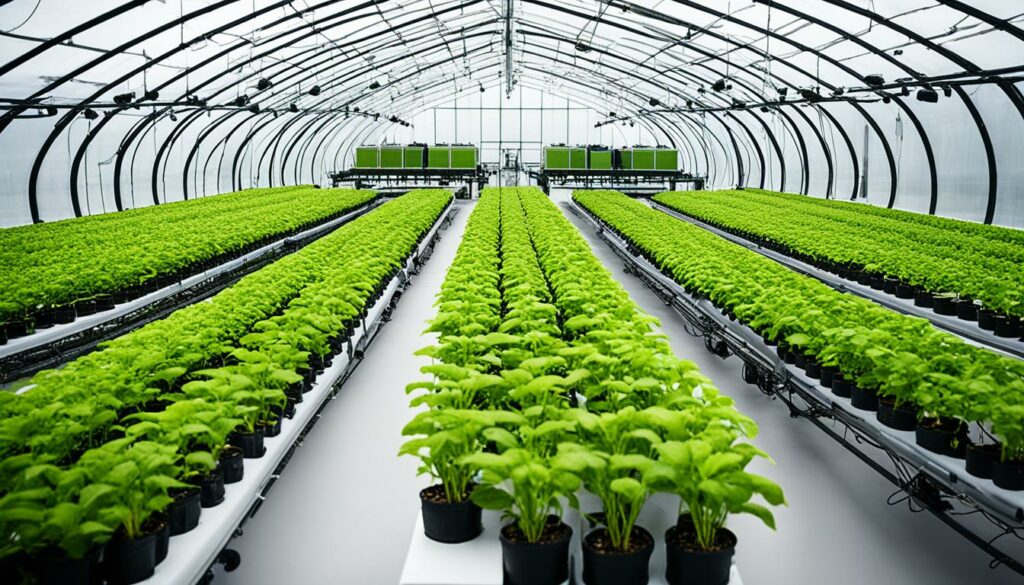
The agricultural robotics market is growing fast and is expected to be worth $94.22 billion by 2030. These robotic systems are making farming more efficient, productive, and kind to the environment. They’re perfect for looking after crops in greenhouses, where a lot of work needs doing, worth about €15 billion.
Horticultural automation can fit any type of farming need. It makes growing crops in greenhouses more efficient and effective. In places like Almeria, Spain, where there are many greenhouses, this technology is changing how farming works.
Since robots in these setups can quickly start saving money, their value is clear. They pay off on average in 1-1.5 years. They can also cut costs by half over five years. Plus, they get help from government subsidies, making them a smart investment.
Robots are also gathering important, location-tagged data in greenhouses. This data is vital for making predictions about crop yields and finding pests early. It helps farms be more productive and keeps them eco-friendly.
After more than 20 years in greenhouse management, I’ve seen AI change everything. It’s making farming more efficient. Machine learning helps us grow crops better and understand data more clearly in greenhouses.
AI in farming lets us use big data to make better choices. For example, Deep Image Recognition spots diseases and pests early. This saves our crops.
AI farming systems can remember what worked well before. They set the perfect conditions for crops and can even predict future needs. For example, Grodan’s e-Gro can tell how much we’ll harvest up to 4 weeks ahead.
There’s also something called Edge-AI. It makes decisions quickly based on new info. Big data helps plan which crops to grow and when. Soon, all this tech might lead to farms running on their own.
We need these AI systems to feed a growing world. By 2050, over 9 billion people will need food. Current numbers show we need to feed 810 million hungry people now.
The EU will spend a lot on smart farming by 2025. By 2030, smart tech could increase crop yields by 60%. This shows the future is bright for high-tech farming.
The future of farming with AI is a big deal. It’s more than a step forward; it’s a leap. It promises more food, better crops, and greener practices. Let’s welcome these changes for a brighter future.
In the end, embracing these new systems shows how tech is vital for farming. It leads us to a future where we farm smarter, not harder. We’re on a path to a better, more sustainable way to grow food.
Robotic greenhouse management marks a big leap forward in agriculture. It combines precision farming with high-tech automation. This combo boosts farm work in amazing ways. Let’s delve into the top gains of this change.
Robot-run greenhouses work much better. They handle tasks like planting and watering precisely. Because of this, farms get more produce and waste less.
This kind of care leads to denser plant life, upping the harvest. Robots don’t make mistakes in what they do. They water and feed plants exactly how they need. Because of this, we expect the farming robot market to grow by 34% a year. By 2030, it could hit $94.22 billion.
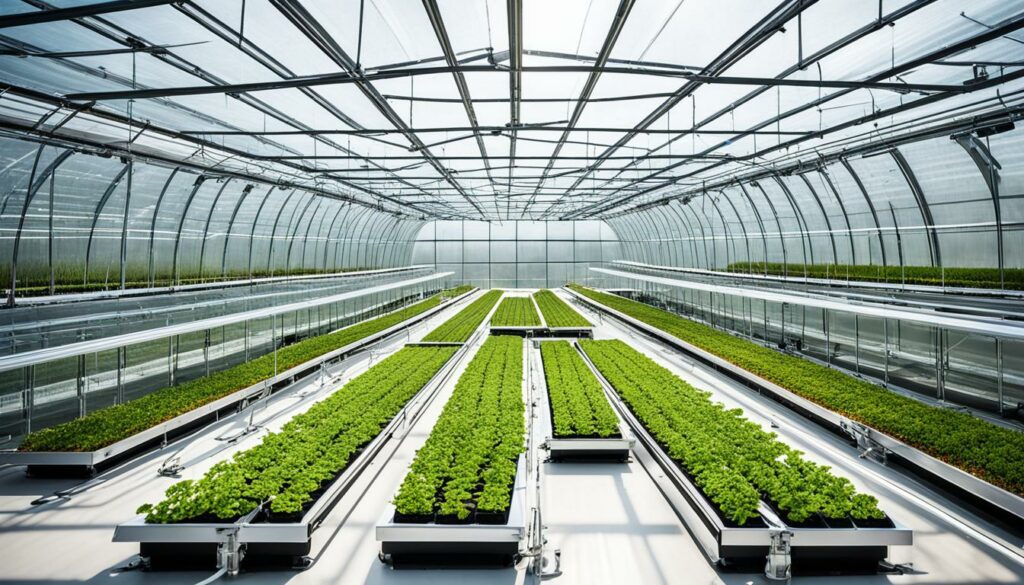
Using robots in farming cuts down on manual work needed. This is really important in today’s market. Jobs like picking crops or setting plants apart don’t need as many people now. Metrolina Greenhouse in North Carolina shows us how. They used HV-100 robots and their plant capacity went up by 5-15%.
This drop in demands saved them from more work injuries and claims. Using fewer workers means saving money. It also makes farms work better and make more profit.
Adding robotic and smart systems to your greenhouse is a big plus. You find your farm works better and costs less to run. This is just the start of a brighter future for farming. A future full of more and better food, grown smartly and safely.
The agricultural robotics market is set to grow to $94.22 billion worldwide by 2030. This shows a lot of people are excited about using robots in greenhouses. However, there are some big hurdles to cross.
Developing robots for greenhouses brings many technical complexities. Making grippers that are gentle yet strong is hard. They need to not harm the fruits and vegetables while working tough jobs.
They also have to cope with the tough conditions of greenhouses. Adding AI algorithm challenges makes it even tougher. These systems have to work smoothly. But this brings in high costs of using smart cameras and sensors, making things even more difficult.
Then, there are the economic considerations. Getting robotic systems into greenhouses is costly. It’s not just about buying the robots. You also need money to set them up and make them work with what’s already there.
Seeing a return on this investment might take a while. This makes people less eager to spend so much at the beginning. Planning your finances well and looking carefully at the risks can help. It makes sure these high-tech moves can last.
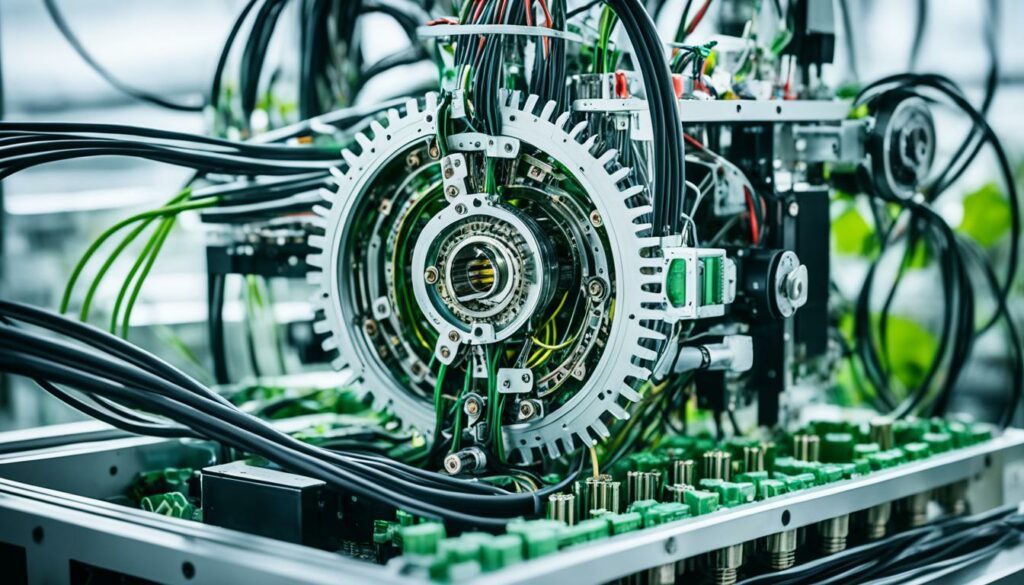
Despite the challenges, the benefits of using robots in greenhouses are clear. With good planning and new ideas, we can beat the technical and economic hurdles. This will lead to a better, more sustainable way of farming.
Robotic greenhouse management is a key leap in farming technology. It brings independent greenhouse work to the cutting edge of agriculture. These high-tech systems handle many farming jobs with great accuracy.
The world market for farm robots is growing fast and is expected to hit $94.22 billion by 2030. This growth is fuelled by a steady 34% yearly increase. It shows that more and more farmers are relying on robots to boost their crops and cut down on waste.
Thanks to robots, farmers can plant seeds with exactness, which means more crops and less waste. Yet, these systems can be costly and complex.
Robots now help with watering and giving plants the nutrients they need. This high-tech approach cuts down on water and nutrition wastage, making farming more eco-friendly. Robots are also used to spot and tackle weeds and pests without using too many chemicals.
For picking crops, robots are changing the game, saving farmers money and time. They can deal with soft or oddly shaped fruits and vegetables, showing great promise.
But robots aren’t just for the hard work. They keep an eye on the plants, collecting data to catch problems early and boost crop yields. This smart use of data is essential for running greenhouses well.
Switching to fully automated systems takes careful planning, considering costs, how well they fit with other systems, if they can grow with your farm, and following the rules. Usually, farms see a big cut in costs after investing in these robots for 1-1.5 years.
For example, the Almería Agriculture Hub in Spain is a big success with robotic farming over its 30,000 hectares. In the U.S., the number of greenhouses growing vegetables has gone up by 115%, showing the trend for more automated farming.
In summary, using robots in greenhouses is changing how we farm. It offers more accuracy, cares for the planet better, and makes farms more efficient.
Robotic technologies are making their mark in agriculture, especially in commercial nurseries. These places are not only using agricultural automation but are also changing how horticulture is done with their new methods.
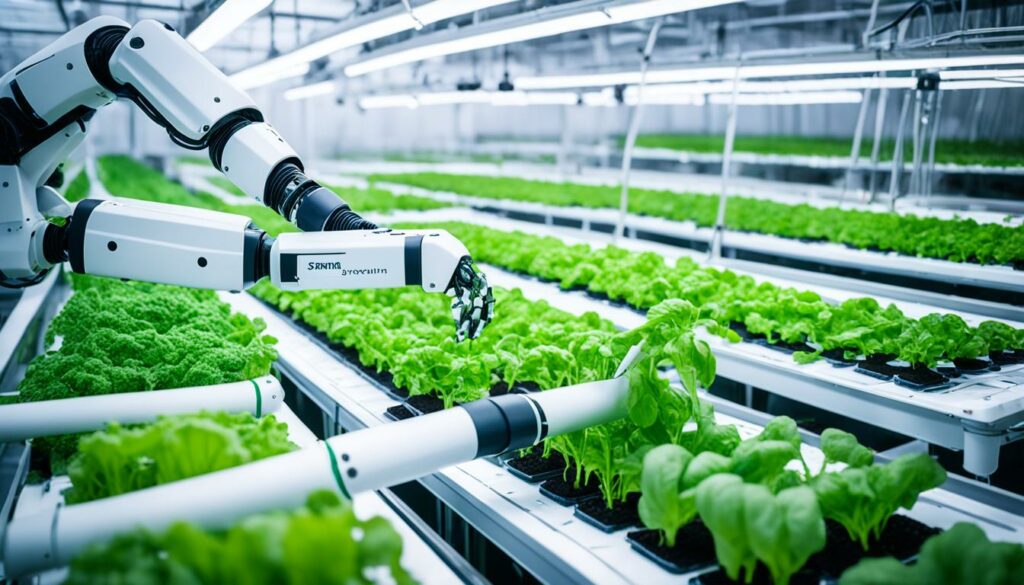
In the Netherlands, a basil farm in a greenhouse cut waste by 50%. This was thanks to insights gathered by robots. In Japan, strawberry farms saw their fruit yield double with the help of robotic pollinators. This shows how innovations in horticulture can up productivity and save resources.
These case studies highlight some key points for successful automation. Using data well is important. A berry farm achieved 96% harvest volume prediction accuracy with robotic measurements.
Also, teamwork between tech developers and growers is crucial. It ensures solutions are practical and fit the farms well. They should focus on early stages of software/hardware design and make prototypes. This reduces technical issues and improves processes before using them in the market.
Understanding and using these elements can lead to big changes in commercial horticulture. This promotes efficiency and sustainability in the sector.
| Study Focus | Percentage |
|---|---|
| Software/Hardware Redesigning and Development | 39% |
| Prototype Crafting | 26% |
| Academic Robots | 21% |
| Test Results in Operating Environment | 13% |
The use of technology in precision agriculture is changing how we farm. It makes growing plants more efficient and productive. The global market for agricultural robots will likely hit $94.22 billion by 2030. This growth is because we need more food, but we have fewer people willing to do the hard work.
Modern farms rely on environmental control systems to grow plants perfectly. These systems use smart watering and feeding to save water and nutrients. They also include self-driving vehicles to beat weeds and bugs. These tools make farming not only efficient but also kind to our planet.
Farm robots do almost all plant-related tasks now, from planting to picking. This change means farmers can save a lot of money on workers, up to 20-30% in fact. Machines that pick crops also make farming faster and cut waste.
Robots are essential for keeping a close eye on plant health. They check the environment and stop problems early. This saves crops from dying and helps farmers grow more food.
But, getting into farm robotics needs careful thought. Before you start, look at costs and see how it fits with what you already do. Think about after-sales support and training too. And, don’t forget about following the rules. Doing these things right will make sure you get the most from high-tech farming.
| Aspect | Impact |
|---|---|
| Labour Cost Reduction | Up to 20-30% savings by automating labour-intensive tasks. |
| Resource Efficiency | Reduction in water and fertiliser usage by 20-30%. |
| Weed and Pest Control | Reduced pesticide usage by up to 50%. |
| Space Optimisation | Increased crop productivity by 50-100% with vertical farming systems. |
| Human-Robot Collaboration | Increase in farm productivity by 10-15%. |
Integrating environmental control systems in farming is a game-changer. By looking after plants so well, these systems boost efficiency and output. They help us farm better, more produce, and look after the planet better.
In horticulture, using advanced automation changes the game. This is what smart farming is all about. It runs every task through tech. With this, agricultural automation systems boost the efficiency and output of greenhouse work.
Greenhouse automation speeds up and perfects tedious tasks. It uses AI robots to perfect growing conditions and protect crops. This horticultural technology also saves water and precious resources.
Robots with AI find pests and problems early. This early warning reduces unhealthy chemicals and cuts waste. Plus, AI helps predict crop health and how much you’ll yield, aiding smart choices.
Robots can help greatly with a lack of farm workers. They do the simple tasks, letting farmers focus on bigger things. AI means you can grow food always, beating the weather and making sure you always have fresh produce to offer.
Getting started with robotic farming costs a lot. But, as tech gets better, it will get cheaper and easier. Both tech geeks and farmers must keep working together. This union ensures that AI and robots fit perfectly into farming life.
AI, robotics, and smart tech keep getting better. They make farming connected and smart. New ways to look after plants and use fewer people can help greenhouses do their best. Scientists are exploring new ways for robots to help with farming.
New tech can detect pests without destroying plants. It’s a big plus for the earth. Science works with farmers to test and use new ways to make growth more sustainable. Automated control of things like weather and water helps farming grow bigger, better, and with less energy.
To run a good farm, you need quality tools and support. This includes lots of sensors and the right software. By working with experts, farmers get the best tools. Together, they design and build new kinds of farms, which are good for the planet.
The Wageningen UR Greenhouse Horticulture team makes greenhouses that fit plants and the area perfectly. They work on things like how to best use light and strong covers. They aim to produce in a way that’s as clean as possible. This method uses water well and looks to grow based on recycling. Greenhouse horticulture is key for making food and flowers in a way that helps the earth.
Robotic greenhouse management shows both tech progress and earth-friendly farming. It helps cut down on harmful gases and boosts money-making in farming.
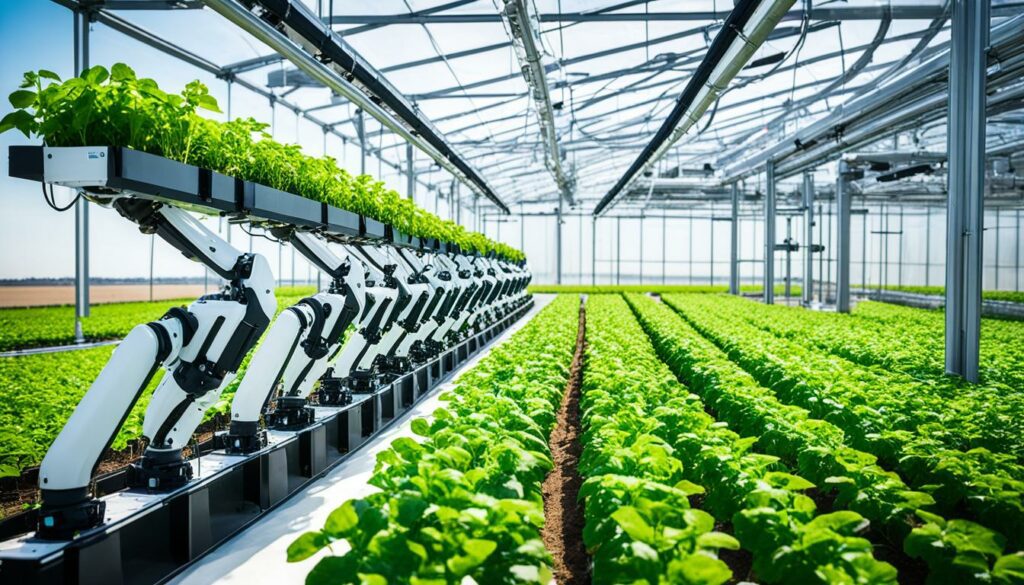
Robotic systems help in using resources better and farming more precisely. In Michigan, greenhouses are a big deal, making over $740 million a year. They’ve cut a lot of greenhouse gases with almost 48 million square feet of greenhouses. This is the third most in the U.S. The success of this effort is thanks to projects like OptimIA, made possible by Michigan State University and the U.S. Department of Agriculture.
Adding advanced tech to greenhouses helps with money. This is because tech makes things more efficient, saves on costs, and brings in more money in the long run. In Michigan, experts are studying how specific lights impact plant growth. This research could make growing plants even more productive.
Here’s a table showing how Michigan’s greenhouse industry impacts the economy and environment:
| Statistic | Michigan’s Greenhouse Industry |
|---|---|
| Economic Impact | Over $740 million annually |
| Employment | More than 9,000 people |
| Square Feet Under Cover | 47.9 million sq ft (3rd in the U.S.) |
| OptimIA Project Funding | $2.7 million (matched to $5.4 million) |
| Fresh Culinary Herbs Project Funding | $3.4 million |
Using tech for greener farms and lessening greenhouse gases is vital. It makes the farm world more sustainable and strong economically. This way, greenhouses can keep growing quality food for many years.
Investing in greenhouse technologies is on the rise. It’s vital to find the right insurance to keep these assets safe. There are many insurance options for every part of an automated greenhouse. They help keep the business going, even when facing risks.
When it comes to insurance for a modern greenhouse, there are a few essential types:
Having the right insurance is key to managing risks. It also helps keep the greenhouse running smoothly.
Greenhouses need strong risk management to succeed:
A comprehensive horticultural business insurance is crucial. It protects the business financially and keeps the modern greenhouses working. This way, both the investment and production are safe.
The future of farming is being revolutionised by technology, especially in horticulture. We see robotic greenhouse management becoming a reality today. This move is not just about dreams but about changing how farming works now. It’s tackling the high cost of labour, with 30% of expenses going to wages, and the challenge of not having enough people to work [9]. This change makes using new tech cost-effective.
Looking more closely at how robots can help in farming, we found a lot of information. From 2015 to 2020, 2639 articles were reviewed to find 38 relevant studies [21]. These studies mainly looked at using robots to grow specific crops, such as sweet peppers and tomatoes. The research focused on making better software and hardware (39%), creating prototypes (26%), and testing commercial robots in real settings (13%). This work shows the big promise of using robots in greenhouses. By controlling the climate well, like adjusting moisture, light, and temperature, we can grow plants better and get more produce.
Another big step is adding many types of sensors in greenhouses. Using sensors to check humidity, light, and temperature shows it’s possible to keep ideal growing conditions. Controlling these factors with fans, exhausts, and heaters, using special prototypes, is key. These developments underline the importance of always trying to do more in automated farming. They ensure greenhouses are versatile and strong. It helps increase farm output.
In short, agriculture’s tech progress is changing how we farm, driving growth and eco-friendliness. Robotic greenhouses are at the heart of this change, letting farmers do better with technology. It’s about moving forward from the old ways to new, more precise, and efficient practices that also care for the environment. This tech effort doesn’t just boost how much we grow, but it supports farming that’s better for the planet. It’s a new chapter of growth and innovation in farming.
Robotic greenhouse management uses automated systems and AI to grow plants better. This includes smart irrigation, controlling the climate, and farming with more precision. It helps make farming in greenhouses more efficient and productive.
AI is key in managing greenhouses. It looks at big amounts of data to improve choices. With AI, we can make growing conditions better, guess what plants will need, and increase how much we grow.
Automated farming has a lot of advantages. It cuts down on working costs, controls planting and growth precisely, and harvests well. This means more plants, better use of resources, and higher quality crops.
Big-scale greenhouses work best with automation. They can be updated easily. Also, using methods like growing plants vertically and hydroponics work well with high-tech solutions.
Today’s greenhouses use high-tech systems to control the environment. They watch and adjust the temperature, moisture, and light. This makes sure plants get the best conditions for growing, leading to a better harvest.
Smart irrigation does watering in a smart way to save water. It fits all kinds of growing, from soil to soilless. The goal is to use less water without hurting the plants.
Setting up robotic systems means dealing with tricky tech problems. For example, making fragile tools to pick plants. Also, the cost is high and takes time to pay off.
Precision farming uses advanced tech to improve every stage of plant life. It uses resources better, grows more plants, and gives data for getting better all the time.
Greenhouses need good insurance that covers their technology. This includes insurance for crops and machines. It helps protect against big losses and keep the farm running.
Robotic greenhouses help the planet by using resources better and making less waste. They’re good for the environment and the business, making it possible to farm well for a long time.